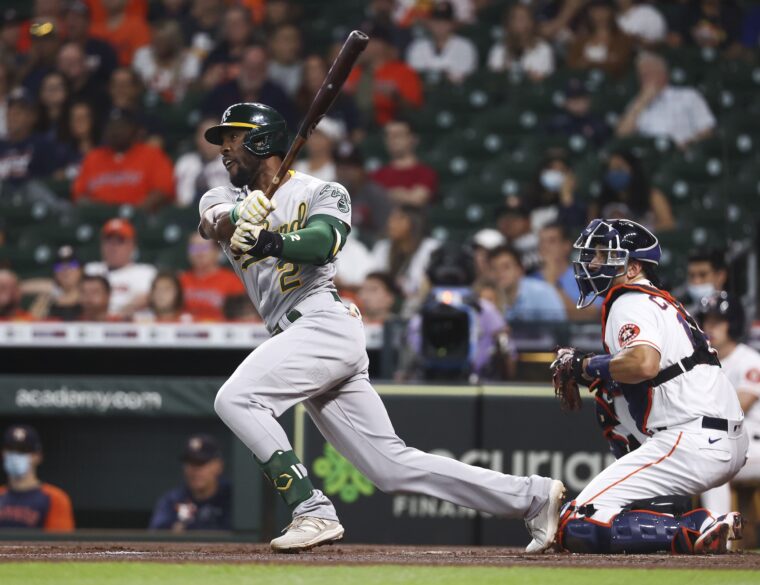
There’s no way around it — the New York’s Mets’ Black Friday shopping spree was incredibly fun to watch unfold. Among the three position players they landed within a span of a few hours, taking center fielder Starling Marte off the market to the tune of four years and $78 million was probably the most exciting of all.
His presence in Queens immediately changes a few things for the Mets. One is that he brings a legitimate threat to steal bases every day. He stole a career-high 47 bags in 2021, has eight different seasons of at least 20 steals, and his 296 career thefts since debuting in 2012 are the third-most in baseball. Being a natural center fielder will allow Brandon Nimmo to finally take up residence in a corner outfield position, as well. Speaking of Nimmo, Marte will also join him at the top of the batting order to create a dynamic table-setting duo for the middle of the lineup.
Marte has been an above-average contributor for the majority of his big-league career. In parts of 10 seasons, the 33-year-old has produced seven years of at least 3.0 fWAR, including three of 4.0-plus fWAR. Marte’s 2021 campaign was different because it was actually a career year for him.
How His 2021 Performance Leveled Up
While Marte only played in 120 games last season, he made them count. Through 526 plate appearances, the veteran slashed .310/.383/.458 with 12 home runs, 55 RBI, 89 runs scored, and 47 stolen bases. That all sussed out to a 134 wRC+ and 5.5 fWAR. He secured a number of new single-season career-high marks during this campaign, including his best on-base percentage, slugging percentage, wRC+, and fWAR. His 47 stolen bases tied the career-high number he collected in 2016. His .310 batting average just barely missed being a new personal best (he hit .311 in 2016), and his .841 OPS is the second-best mark of his career (.845 in 2019).
Just how much did his production increase, though? Here’s a look at how his numbers from 2012-20 compared to his 2021 performance in a few key areas.

Although his power went down slightly, it’s stayed in the same neighborhood while everything else made a noticeable increase. How did he get here?
Improved Plate Discipline
The thing that sticks out the most in the above table is Marte’s increased walk rate. Heading into 2021, he never posted one higher than 6.1%, which came in 2014, and it had been below 5.0% four times since 2015. So, seeing it jump all the way up to 8.2% is eye-opening, especially for someone who has racked up as much playing time as Marte has over the years.
He’s built up a reputation as being more aggressive at the plate, and although that didn’t necessarily change last season, he showed increased restraint. Here’s how his plate-discipline numbers progressed each year since 2017. Marte’s chase rate (O-Swing%), swing rate on strikes (Z-Swing%), contact rate (Contact%), and swinging-strike rate (SwStr%) are all highlighted below.

He only played in 77 games in 2017 because he was suspended for performance-enhancing drugs, but it was also the year in which he posted the lowest chase rate of his career. That number increased consistently each of the following three years until it dropped to what he did in 2021. Even with swinging slightly less often compared to previous seasons, he made the same amount of contact and didn’t swing and miss nearly as often as when he was more aggressive at the plate.
Heavy on the Ground Balls
When looking at Marte’s quality of contact, his 18.9% soft-hit rate and 32.9% hard-hit rate were on par with his career numbers (18.9% soft-hit rate and 32.5% hard-hit rate). The same could be said for his line-drive rate (21.1% in ’21, 21.3% for his career), but in a full season’s worth of play, his 54.8% ground-ball rate was the highest it’s ever been, while his 24.1% fly-ball rate is his second-lowest mark.
The 33-year-old obviously has some wheels, but it’s still eye-opening to see him post a .372 BABIP. Among hitters with at least 500 plate appearances in 2021, Marte’s BABIP tied with Tim Anderson for the highest in baseball.
Hitting a lot of ground balls isn’t new for Marte, though — it’s something he’s done his entire career. He’s finished a season with a ground-ball rate of at least 50.0% seven times, including each of the last four seasons. And while this past season’s BABIP sticks out, he’s accumulated a career mark of .344, so he typically seems to rack up base hits on balls in play more often than the average dude.
His 86 wRC+ and .670 OPS on ground balls in 2021 were among his single-season career-high marks, but he’s also historically had a decent amount of success for this batted-ball event. Since his debut in 2012, Marte has posted a cumulative wRC+ of 66 and an OPS of .611 when he puts the ball in the ground.
Current Projections For 2022
Understandably so, Marte’s current projections are predicting a step back from last season’s performance. Steamer has him tabbed for a 110 wRC+ and 3.0 fWAR, while ZiPS has him at a 106 OPS+ and 2.8 fWAR. The Average Total Cost (ATC) projections that were recently released also tabbed him for a 110 wRC+ and 2.9 fWAR. Regarding other statistics, all three systems are projecting a triple-slash in the vicinity of .270/.330/.420 and at least 30 stolen bases.
Can Marte reproduce what he just did? Well, that’s of course possible. He’ll likely need to keep up his altered approach at the plate while maximizing his contact to make it happen. Even if his numbers slip back toward the mean and are similar to what’s above, his presence at the top of the Mets’ everyday lineup will be a huge plus for this club.
















